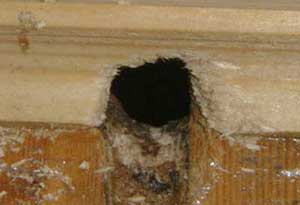This symbiotic phenomenon can be observed on the desert steppe of Xinjiang, Qinghai (China). For example, wild mice can be seen alongside snowfinches or Eurasian tree sparrows.
 |
|
Mouse Hole (Photo: kittywompus) |
There have been accounts of birds standing on the backs of mice, moving together, spreading their wings, and emitting complex calls without flying away.
The reason for this situation is the significant temperature fluctuations on the desert steppe, with a high difference between day and night temperatures. There are few dense forests, which eliminates potential nesting sites for birds and places to hide from predators. In this region, wild mice are very common, with mouse holes scattered everywhere. The temperature inside these burrows is stable, providing protection from both heat and cold, making them an ideal environment for birds to nest and breed.
The coexistence of birds and mice benefits both parties. The birds are very vigilant and can serve as sentinels for the mice. If danger approaches, the birds will immediately take flight and call out loudly, alerting the mice to retreat into their burrows.


















































